
Laminated Yeasted Dough Construction
Hi,
I thought some detail on creating laminated dough for croissants etc may be a popular subject.
CROISSANT DOUGH
|
MATERIAL |
FORMULA [AS % OF FLOUR] |
RECIPE [GRAMMES] |
RECIPE [GRAMMES] |
|
Strong White Flour |
100 |
600 |
1000 |
|
Salt |
1.3 |
8 |
13 |
|
Milk Powder |
5 |
30 |
50 |
|
Fresh Yeast |
6 |
36 |
60 |
|
Cold Water |
63 |
378 |
630 |
|
SUB-TOTAL |
175.3 |
1052 |
1753 |
|
Butter |
41.7 |
250 |
417 |
|
TOTAL |
217 |
1302 |
2170 |
Method:
- Mix the ingredients for the dough to form cool, developed dough.
- Put in a plastic bag in the chiller and rest for 30 minutes. Cut the butter into 4mm thick strips and put back in the chiller.
- Roll the dough out to a rectangle 8mm thick. Put the butter pieces flat onto 2/3 of the rectangle, and fold as below:
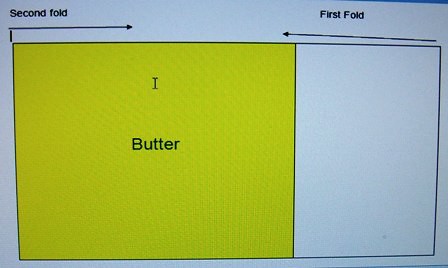
- Turn the dough piece clockwise through 90°. Roll out to the same size as before, fold as above, and turn. Repeat once more.
- Chill the billet for half an hour and give 2 more folds and half turns as described. This gives 168 layers of butter in the croissant dough. Chill again for half an hour.
- Roll the dough piece out to 5mm and use a croissant cutter to cut out triangle shapes. Stack into piles of 6 and rest covered for 2-3 minutes. You can use a template made from wood, or, cardboard, to cut out the individual triangle shapes instead. Please see the video, at 1 min 35secs, for a brief view of the croissant cutter on the left of the screen.
- Tease out each triangle, fold up the top edge and roll up tightly. Roll out the feet to pointed ends and move round so these feet join up to make the classic shape. See Vicki demonstrating this in the pictuure below. For Pain au Chocolat and Pain Amande, cut the dough into strips, 6 x 10 cm; cover with small chocolate chips, or a thin layer of almond paste, and roll up so the seam is well pressed down on the bottom.
- Place on silicone lined baking sheets and brush with beaten egg. For the pain amande, dip in flaked almonds
- Prove at 38-40°C, 80%rH for 40 minutes.
Bake in a hot oven, 235°C for 12-15 minutes; a deck oven should be set at 7 for top heat, and 5 for bottom. No steam is used, and a damper is not needed.
[Almond Paste to make Pain Amande]
150g Icing Sugar, 150g Caster Sugar, 300g Ground Almonds, 50g Egg, beaten, 1 tbsp Lemon Juice
Key Principles of successful laminated dough:
- 1. The dough should not be too wet. If the dough is soft, it will stick to the bench and the pin, and the laminations will quickly be ruined. If the dough is too tight, it will be difficult to roll out without the dough insisting on springing back. Some have advised that the dough need not, therefore, be fully-mixed. This is because all the rolling and folding will continue the dough development. My own thought on the matter is that the dough should be developed to the level allowed by the choice of flour used. So if a top grade flour is used, the dough should be mixed accordingly. If the flour is not so strong, it will not tolerate intensive mixing anyway; by hand, or, machine.
- 2. The best way to deal with dough which springs back is to allow extra resting time. Allowing plenty rest between turns is the first key principle to grasp. If you compare the folding process to working out bicep muscles in the gym, you should not go far wrong. Bicep curls would be repeated to the point where the muscle is so tensed up it cannot do any more. After a period of rest the same moves are repeated. The moves are designed to strengthen the muscle by continued work. But there has to be rest in between to allow the muscles to relax. It is exactly the same for the gluten-based protein fraction in the dough.
- 3. The other key principle is to be able to work cold. It is generally cold and raining here in the UK, but I am aware many who write on this site have problems creating cool enough conditions in the kitchen to lessen the burden of making these items; I wish I lived where it was warm too, don't you believe it! Here are a few options:
- Use a chilled marble slab, or, a refrigerated work surface.
- Use crushed ice in the dough, or chill the dough water for an extended period prior to dough mixing.
- A good trick is to chill the dough overnight. Give the dough 3 half turns, then bag and chill overnight. Waken up early the next morning, give the dough its last half turn and process from there. Bake off the croissants and serve straightaway for breakfast. You have just made yourself soooo popular with everyone in the house, forever!
- 4. What about the choice of laminating fat? Commercial croissants tend to be made with specialised and plasticised fats. This means the final product tends to be just a lot of air! Worse still if the fat is cheap, the melting point will be high, and the product will stick in the roof of the mouth [palate cling] These fats are not exactly renowned for their health-giving properties, either. So they are used on cost and performance grounds. As far as I am concerned croissants are made with all-butter. It is possible to buy a concentrated butter commercially. This is great, because all the water has been removed, so it means the butter block can be rolled out to a sheet, without it melting. Household dairy butter has a water content of 15-20%, so the problem with not working cold, is that the butter can easily start to melt, meaning the death of all the laminations you have worked so hard to achieve. So, performance-wise, butter is not the best, but for flavour, it obviously has no competition. I'm pretty sure concentrated butter is only available commercially; this is definitely the case for the UK and rest of the EU too.
- 5. Regarding lamination; due care and skill is the 3rd principle. I teach that croissant are given 4 half turns. Danish are often given only 3. Full puff paste employs equal laminating fat to flour used in the dough. This is usually given 6 half turns. The more turns, the more layers created. Above I state 4 turns gives 168 layers. Another 2 half turns works out as follows
168 x 3 = 504 504 x 3 = 1512. So many layers is incredibly difficult to achieve. Yet, to commercial bakers it is essential. The number of layers dictates the amount of "lift" in the product, giving greater volume to weight ratio! This affects product yield; well-aerated puff paste yield more products. Given these doughs use expensive ingredients, a baker cannot afford to miss out on achieving correct product yield.
- 6. In terms of volume and lift, it is important to explain how this works with yeasted doughs like these. When the product goes into the oven, the fat layers melt into the dough layers beneath, creating cavities between the dough layers. These cavities are filled with steam from the water content of both butter and dough. The steam exerts pressure on the dough layer above, causing the product to expand. See diagram below. So, it follows that the more layers, the greater the pastry will rise. So, what of the yeast? Well, the benefit is in terms of a first fermentation for sure, but it has to be achieved in cold conditions, as we have noted. This should mean the yeasts are far from worked through when the croissants are set to prove. Note the yeast level is relatively high. Any benefit has to be derived from rapid expansion as the croissants hit the hot oven. So, testing the dough for evidence that fermentation is slowing down is not a relevant test. We have no need for any sort of complex fermentation at this stage.

7. Lastly, oven treatment tends to be incredibly forgiving to croissants , so long as the oven is hot enough. Although, I think I'd be hedging my bets with items that were becoming tired and spent, in line with the notes just above. My practical classes last anywhere between 3 and 5 hours. 3 hours is really not very long to make these items with skill from start to finish; and the resting between turns really can be so crucial here. But I cannot think of a single class I have facilitated on this product where the students have been anything other than delighted by the tasks they have carried out, and the products they have made. It's the colour, and aroma; these items just look and smell great when they are baked. Fabulous!
See the photos attached below, and the link to the video below that.

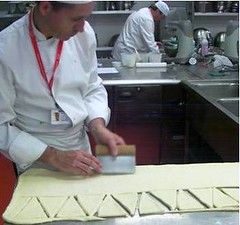
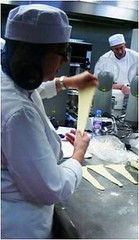



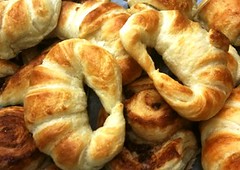

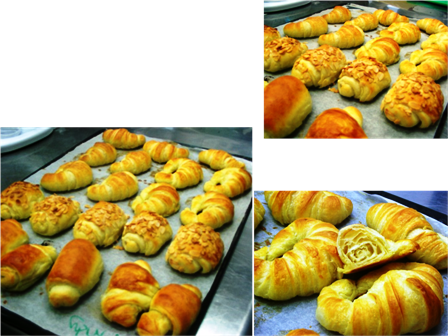
Here's the video:


Comments
Never mind about the posting error Akiko
The lamination in your croissants is superb.
Best wishes
Andy
Thank you for your thoughful words, Andy.
Your recipe is great!
Thank you,again
Akiko
Hey Andy!
What a wealth of information. I've scribbled 10 pages or so in my big black baking book.
With so many tips and pointers under my belt, all I have to do now..is make it work!
Thanks again for sharing this.
Freerk
Hi Andy,
Wow! What a goldmine of info on croissants - my favourite subject and pastry. I know this post was commenced in 2010 but stumbling accross it, I still have some questions in 2012.
1. Why does the recipe use milk powder instead of liquid milk? Is this an economic factor? And what would the effect be on the water/liquid content be if real milk was used? If using real milk in place of powdered, what would the volume be? Is there a difference between skimmed / 2% fat / full cream milk in the recipe?
2. When I roll out and trim my dough for croissants, snails/escargots and pain au chocolat, there are the trimmed pieces left over. Accepting that the ingredients for croissants are costly, can one re-cycle this left over dough? Piece it together and re-roll to stretch the production yield? Or will this compromise the laminating integrity and strength considering that it's bits 'n pieces stitched together?
I have inserted a pic of my croissant. I am trying to develop and achieve the "honeycomb" appearance of the crumb and although it's slightly evident near the centre I just don't seem to get it right! Is this a technique fault or maybe the flour we use here in Johannesburg South Africa? I am happy with the crust (very flaky) and the layers (happily I have a dough sheeter) but the interior still confounds.
Please help!!
Paul
Hi Paul,
Thank you for writing such generous comments.
Regarding milk powder I use it in place of milk for several reasons. These include:
http://www.thefreshloaf.com/node/12076/why-milk-powder-milk-bread-and-not-just-milk
I don't work in volumetric measuring at all; everything is weighed in grams/kilos; no exceptions. See comment above about why powder benfits here; you can choose your own level of enrichment and still keep the liquid content as constant.
Trimmings: So long as you keep them in good order, they can be added back into the next billet of croissant dough in the laminating process. Adding scrap back at 5-10% would be acceptable; exceeding this would impair the dough. At home, when using smaller quantities, I tend to put scrap pieces together and roll out into a rectangle which allows me to make a few Palmiers as little fancies to give to dinner guests, or put out as tasters at the Market stall.
There is no photo in your post, unfortunately, so I can't really comment on your last question. What I would say is to make sure you follow basic principles carefully. Use a formula you trust [mine above is well tried and tested, and I rarely deviate from it], use a good quality flour...not too strong and not excessively developed, but a soft flour is not appropriate at all. Work cold; rest between turns; construct your lamination with great care. If you do all that and then take care with constructing the products, and you should be home and dry. What oven do you bake in? Croissants bake well in convection ovens, but, as ever, I so much prefer deck ovens.
Best wishes to you
Andy
Great enlightenment.
Can you see this pic of the croissant now?? I am simply copy and pasting. Is this not the correct process for inserting pics?
My flour is a 60:40 mix of cake:bread. (Both flours -Eureka- are cold stone ground unbleached non additive flours.) The cake flour protein content is 11.02% and the bread flour content 11.22%. The unsalted butter has a fat content of 88%.
Here is the crumb structure pic:
I bake with a twin-fan convection oven (Piros ex Italy.)
Thanks again for all your guidance.
PaulZ
Not quite sure why the pic is not displaying?? Not simply C & Paste?
Hi Paul,
If you look in the FAQ section using the tab at the top of your TFL homepage, Floyd has posted instructions how to load photos. I use flickr as a host for my photos and then paste the flickr link in using html.
I now know where your problem is. Using cake flour is not a good idea at all. Ok, so the protein level maybe acceptable. However, the fine grind means that there is an excess of starch damage in the flour. This means that, once hydrated, the enzyme reactions converted starch to sugar [amylase] will kick in straightaway. This accounts for poor dough structure, which is why you are disappointed with the interior of your finished products. You should use all bread flour; problem solved.
All good wishes
Andy
Hi Andy!!!
Gee whizz! I just love this site and the brains that tap into it!
Thanks for the info re: the bread flour vs the cake flour. My only concern is that when I tried 100% bread flour, the rise wasn't all that good. Less rise than using 100% cake flour. However, you are advising 4 half turns and this may also solve some of the problem. (I currently roll it out 3 times to 6mm after each half turns, store in the freezer for 30 -40min between turns (as per Ciril Hitz method) and then roll out again to a 4mm working thickness ready for cutting and eventual shaping - into croissants, pain au chocolat etc.)
Thanks for all the guidance.
Here's the uploaded pic, eventually!
Bit late to the party, but thanks for the informative post, Andy. It's really helped clear up some lingering cob webs around lamination.
I have a question - if commercial croissant butter has less water than retail butter, would it make sense to add more lamination butter and less water to the dough to try and achieve a similar outcome?
What say you? Cheers.
Hi grind,
Thank you for your kind comments.
Yes, you could increase the fat level if you like. Fat level in croissant paste is generally accepted as being between 30 and 45%. If you go over 50%, then you may need for than 4 half turns to incorporate the fat effectively. There are bakers who use higher fat levels: Michel Roux Snr. for one, and I believe Julia Childs is another. But I stick within the percentages above, as I'm minded to think that more than 4 half turns is moving out of croissant territory and into puff pastes.
The water content is what you need to mix the dough. The flour I use, on a straight dough basis needs 63%. You may be able to reduce this to 60-61%, but it really depends on your choice of flour more than anything. I always use UK Strong flour [Organic, or non-Organic] for croissants.
Best wishes
Andy
Ok, I see what you mean about more butter = more turns. I've been using softer flour so the hydration is lower. A fine balance, indeed. The wiggle room is shrinking! Thanks again.
Hi Andy!
Great post you've got here. I've got a burning question. Generally speaking I think I have managed to get the techniques right (see my picture) but my croissants are never as light as I'd like them to be. I have eaten croissants sold in good cafes in the UK and also in Paris and what I love the most is actually the really light and crisp texture of those croissants. In short I am wondering if the protein content of the flour that I use would make a difference? I have always used all purpose/plain flour from Sainsbury's (student on a budget here) but I am considering switching to strong white flour. Also I'm not sure if I should develop the gluten more by extra kneading or incorporate bulk fermentation of the detrempe. I am always wary of over-developing the gluten because it'd make rolling out later impossible and the prospects of torn layers really doesn't appeal to me.
Anyway here is the picture of my last batch:
And here is the simplified recipe (By Hamelman)
A) Detrempe:12 g dried/instant yeast140ml cold whole milk140ml cold water42g melted unsalted butter, cooled to room temperature504g plain/ all purpose flour12g salt80g caster sugarB) Butter block - 280gI noticed that your recipe uses strong white flour. Any chance you could tell me the protein content of the flour stated in the recipe?Cheers and hope to hear from you soon!Kong
Hi Kong,
Thank you for your very kind words. I should also add that your own croissants look fantastic.
If you buy flour from Sainsburys, you should be able to find the Carrs Breadmaker flour on their shelves. This is the nearest home scale equivalent to the Special CC which I used at the time I wrote the post. Protein level is 11.7%; quality is high. I believe you would need to increase the hydration in your dough a little if you switched to a stronger flour. Secret is that the dough will continue to develop as you laminate....hence why you need plenty of cold rest between turns. But I think you have already figured this out. The photo of yours suggests beautiful attention to the fermentation details too.
All good wishes
Andy
Hi Ananda!
What do you mean by "a deck oven should be set at 7 for top heat, and 5 for bottom."
I use a gas deckoven & can set the temperatures (centigrade)i for for the top & bottom.
I'm from India & I'm really struggling at making croissants. Our ambient temperatures are way higher than the ideal 18-20°c & then there is the problem of of the ideal Butter. Here we can procure 80% fat only. However I shall persevere.
Thanks in advance.,.
Paresh
Hi Paresh,
I've no experience of using gas deck ovens, sorry. The electric deck ovens in the UK from Tom Chandley control the heat sources top and bottom using a range of 1 - 10 on each dial. The overall temperature of the deck is set with a separate dial.
Butter of 80% fat will work fine, so long as you can plasticise it cool enough to stop it melting.
Try chilling both your water and flour overnight in the fridge before you make the dough to keep it as cool as possible.
Best wishes
Andy
Hi Ananda,
Thank you for the prompt reply.
As for the temperatures, I preheat the oven @ 240c top, 200c bottom. I reduce to 220c top & 180c bottom after 5 minutes. total bake time 20 minutes. I get a fine golden brown colour.
The room temperatures here are 30-32C. Even after putting on the air conditioner the temperature doesn't go below 27C. This is probably due to the large room size. For the time being I shall have to learn to live with this.
Let me describe the process I use.
Day 1. The dough is made in the evening with ice cold water with some time in the refrigerator during the dough development stage. Then it is stored overnight in the fridge.
Day 2. Morning. 7 inch/18cm butter block is made between two parchment paper sheets. Then refrigerated. Then the dough is shaped/rolled out to a 10 inch/25.5 cm square. The butter block is place on the dough after it has warmed up so that it can bend without breaking. Then it is rolled to about 60 cm & 3-folded. This is the place I have problems. While rolling the butter shatters( I can see & feel this through the dough). Can you suggest something? I'm always worried about softening the butter as I believe it then incorporate into the dough. this has happened very often during my earlier trials. after the first fold the dough is placed in the refrigerator for about 30 minutes.
Hi paresh,
Yes, I've had this problem when the weather has been very warm.
It can be very difficult to produce a sheet of butter which is sufficiently plasticised without it softening and starting to melt.
If you can find a way to do this, you will succeed. But I'm not sure I can suggest anything else; it's about your own room conditions and finding a way to work with them.
Sorry i can't help you any more than that
Best wishes
Andy
Hi Paresh,
Try to work on the counter that cold on the surface such as cabinet chiller. After you work out the dough, you can easily put the dough on the chiller underneath.
Hi Andy,
Sorry to say bluntly but the photos of that chef and the final products look like bread croissant. They loose the flakey crust which actually the most croissant characters.
Pages